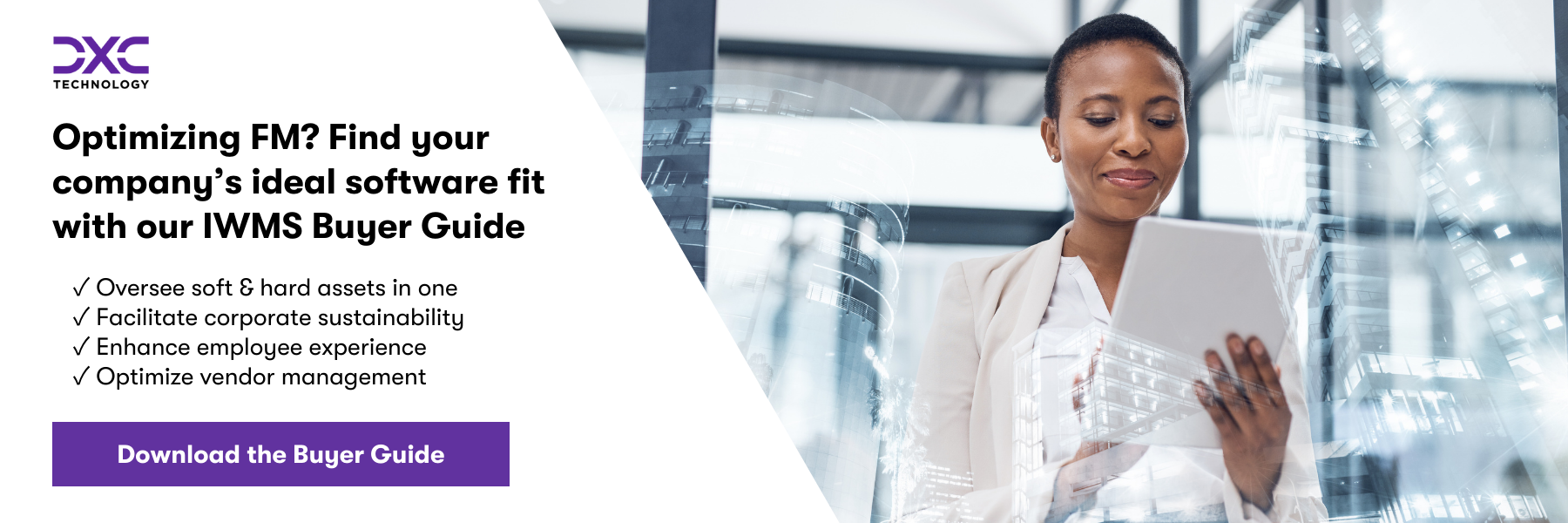The need to minimize costs and maximize efficiency has long been the case in the world of Facility Management (FM). Now, recent megatrends have simply piled on the pressure.
Extracting maximum efficiency and cost-effectiveness out of every square meter of real estate was one thing. Add the need for safe, hygienic, and flexible hybrid work patterns on top of that and it becomes an even more urgent task. As for time-saving, with employees increasingly used to user-friendly smart solutions at home, they’re only getting more frustrated with complex, clunky FM interfaces at work.
So time- and cost-saving is firmly top of mind. As a result, it’s imperative that Facility Managers can find and implement effective software solutions as rapidly and easily as possible.
But where to begin?
With so many software options on the market, making an informed decision can seem like a huge task. The fact that a lot of FM solutions focus on specific soft or hard service management also doesn’t help. Before you know it, you might find yourself considering five to ten software solutions to manage your assets and services — none of which are naturally designed to integrate with each other.
For optimal savings on time and cost, it’s wise to choose an Integrated Workplace Management System (IWMS). This is the case for a variety of reasons — not least that it narrows down your choice of solutions to a more manageable amount!
Besides that, a leading IWMS solution will enable you to oversee the hard and the soft aspects of your FM via one centralized hub. It’ll empower you to streamline your vendor landscape and action preventive maintenance. Finally, it’ll prepare your workplace for the future by laying the groundwork for comprehensive integrations. Below, we’ll take a look at these advantages in more detail.
Combining soft and hard FM to save time and funds
To design and evolve a flexible hybrid workplace, you need an IWMS that oversees your real estate and front of house services in one. Only by centralizing all this data can you create an efficient, seamless system that maximizes asset utility, while keeping employees served and satisfied.
For example, a leading IWMS would store detailed floor plans for your building to map every available desk. For workplace hoteling that’s flexible and puts employee health and safety first, this is key. Next comes the soft service aspect: The user-friendly employee portal in your IWMS, which lets your staff flexibly book and unbook desks via desktop or mobile.
So there are both hard and soft services powering this workflow in your IWMS. In this article you can read more about soft and hard services and why they should be included in your Integrated Workplace Management System.
Now, let’s look at the resulting savings on time and cost.
The soft and hard combination: Time- and cost-effective
With flexible workspace reservations, your employees can turbocharge their strategic and creative work by coming into the office to collaborate with coworkers. At the same time, the hard asset data in your IWMS will ensure they can only reserve a space that’s large and ventilated enough to ensure optimal hygiene conditions.
Conversely, employees can decide to cancel their in-office space and work from home as needed. Perhaps they require more peace and headspace to finalize a report or presentation, or they know there’s significant travel disruption and they’re better off not trying to get to the office. Either way, that’s efficiency boosted and time saved, all thanks to your IWMS.
On the cost-saving side, enabling a workspace hoteling system is a crucial asset in strategic downsizing. With fewer desks that are flexibly available to multiple employees, you can make more efficient use of your resources in every sense. All while enhancing employee experience with your intuitive, pro-hybrid approach.
There’s further hard costs to save, too. If you can integrate your booking and floor plan data, you can optimize lighting and climate control so that it’s only on when and where it’s needed. That’ll cut your bills, and reduce your corporate carbon footprint at the same time.
Streamline your vendor landscape with cost-effective preventive maintenance
An IWMS thriving with hard asset data will empower you to implement pre-emptive maintenance. With information on the recommended check-up schedules for your lighting, heating, air conditioning, fire extinguishers, and so on, your IWMS could generate regular, automatic work orders across your maintenance vendor ecosystem.
The time saved is clear: Plug in the data once, and your building managers will never have to manually check maintenance details, schedules, or contract agreements again. From the automatic work order going to the vendor through to them sending in their invoice, it could all be tracked via your IWMS vendor portal. Add an integration with your finance department, and you’ll save time across the board.
Prevention is most often the cheapest way to solve a problem when it comes to costs. With everything from your drainage to your fire safety preventively maintained, you can avoid expensive patch-ups and emergency fixes. On the employee side, all this can only be positive: Visuals, odors, sensations, and amenities kept in full working order, all the time.
Looking to the future: Data integration is key for optimized FM
In a dispersed, siloed FM landscape, your employees waste precious time. Whenever an issue arises, they’ve got to work out where to log their complaint, how to utilize that particular interface, and remember to follow up as needed.
The fix? Combining all your point solutions in an integrated IWMS. A system that securely houses key employee data across HR, IT, FM, Legal, and Finance would enable your staff to simply use a single platform. Arranging their holidays, receiving and updating their IT hardware, ordering catering or reporting faulty heating, reviewing their contract or submitting work expenses, all in one. Place an intuitive and user-centric interface on top, and you’re all set.
Integration is also your ally when it comes to cutting costs. With a clear overview of HR and IT data in your IWMS, you can ensure costly IT licenses are only extended to employees with the right role or seniority. An accurate and updated record of how much IT hardware is out there among your staff is another advantage. This helps ensure it’s returned as required and that you don’t overpurchase when you already have assets in stock.
These examples makes it clear that integrated data is a key success factor for employee-centric facility management.
For optimized expenditure and efficiency, focus your search on IWMS solutions
Save time on the search itself, and make a wise investment in a leading IWMS. It’ll set you up to manage your existing assets cost- and time-efficiently, while paving the way for your future workplace evolution.
The right IWMS can centralize your hard and soft assets behind one efficient interface, create a one-stop shop for all your employees’ needs, and enhance your FM via leveraging data integration.
That said, the benefits we’ve explored here are only a small slice of how a leading IWMS can help you cut time and costs in FM. To explore the wider potential for an IWMS in your organization, don’t hesitate to download the Buyer Guide: The ultimate guide to selecting your Integrated Workplace Management System.
For more information or advice about adding IWMS functionality in your workplace, don’t hesitate to contact our team.


![Workplace-Header-2048-x-1032-wit[12] Workplace-Header-2048-x-1032-wit[12]](https://dxcservicenowbusinessgroup.com/hs-fs/hubfs/Workplace-Header-2048-x-1032-wit%5B12%5D.webp?width=1946&height=272&name=Workplace-Header-2048-x-1032-wit%5B12%5D.webp)